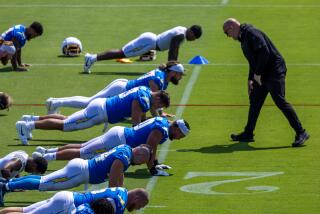Seabees Build Mojave Camp to Train for Mideast Duty : Persian Gulf: The bombing of Baghdad may step up the 130-man detail’s deployment. The exercise mission ‘is even more important now.’
- Share via
TWENTYNINE PALMS — Mike Firme and Jerry Smith were busy in the galley, preparing beef stew, rice and coffee for 130 sailors.
Outside the tiny, fume-filled tent, their fellow Seabees were hammering stakes, stretching ropes, digging trenches, running power lines and squinting, always squinting, against the windblown sand.
Since Monday, a 130-man detail from Naval Mobile Construction Battalion 3, based at Port Hueneme, had been transforming this speck of the vast Mojave into a secure camp--the same kind of job they will soon be doing in Saudi Arabia.
Wednesday afternoon, as the desert camp began to take shape, Cmdr. Chuck Kubic ordered his men to an immediate muster. They lined up within seconds.
“The U.S. has launched an attack on Iraq,” Kubic said. “We are bombing Baghdad.”
As the men looked straight ahead, showing no reaction, Kubic said their deployment to Saudi Arabia, once planned in mid-March, could occur in a few weeks.
But the training mission, scheduled to run through Jan. 23, probably would not be affected, Kubic said. “It’s important training. It’s even more important now.”
The 130 sailors are learning how to build a self-sufficient camp from scratch. They also are learning how to defend it with heavy machine guns, mortars and anti-tank rockets.
The men had 48 hours last week to assemble their equipment--including trucks, bulldozers, forklifts, generators, tents, cooking equipment, shower facilities, food and weapons.
Then early Monday, under cover of darkness, they began flying in the equipment, landing C-130 transport planes on a desert strip at the Marine Corps’ Air-Ground Combat Center at Twentynine Palms. More than half a million pounds of equipment came in 15 planeloads. More arrived on a truck convoy from Port Hueneme.
The first job, even before building the camp, was staking out a defense perimeter to protect it. Then phone lines were laid in the soft sand to connect the defense posts.
That left time to build only a few tents Monday. Most men had to spend that first night in “sleeping holes” dug in the sand. For dinner, they cut into brown plastic pouches called MREs--Meals Ready to Eat--and subsisted on entrees of beef or park patties, ham loaf, or beans and franks, along with crackers, dried fruit, beverage and dessert.
“You wouldn’t believe how hard it is, really,” said Brian Brink, a former reserve Seabee who was activated a few months ago. “You have nothing. Basically, you have to build everything.”
One of the first tasks Tuesday was raising a galley. By dinner time the galley crew had chili simmering in giant pots. But the showers would not be completed for another day.
“I haven’t taken a shower for three days,” Brink said. “I’d love that.”
Although more sleeping tents went up Tuesday, 50-m.p.h. winds almost knocked down one of them Tuesday night.
“The only problem is the wind,” said Seabee John Egan as he reinforced one of the stakes around the troublesome tent. Above him, Gary Smith was trying to hook up a chimney for a heater inside the tent.
“We’re just trying to make life more comfortable in the desert,” Smith said.
In the distance, they could hear machine-gun and mortar fire. While they were building the camp, others were learning how to defend it.
“We can’t be just a construction unit, and we can’t be just a military unit,” said Lt. Steve Wolfe, who is in charge of the desert mission. “We have to be both.”
At the practice range, pairs of men on the ground aimed .50-caliber machine guns at targets on the ridge a mile away. Behind each gun, one man fed the ammo while his partner kept the stream of fire on target. Empty gold-colored shells flew out the right side and clouds of acrid smoke rose from the weapons.
Nearby, other sailors practiced on an M-60 mortar gun. When they fired, a red-orange beam could be seen streaking toward the mountain, followed by an explosion of dust and sand and a wind-borne echo that was almost as loud as the gun’s initial blast.
Wednesday was the only time the men would use live ammunition, but they would get a lot more training in defending the camp. Every other night, a group of Seabees camped about a mile away will be sneaking up on the camp to test its defenses. Each side will carry laser guns and wear laser-sensitive patches on their clothes to help determine who wins the encounters.
Wolfe said that with the start of a real war, the war games will have more meaning. “I’ll see more intensity,” the lieutenant said. “I’ll see more of a group effort. I’ll see more teamwork.”
More to Read
Sign up for Essential California
The most important California stories and recommendations in your inbox every morning.
You may occasionally receive promotional content from the Los Angeles Times.













